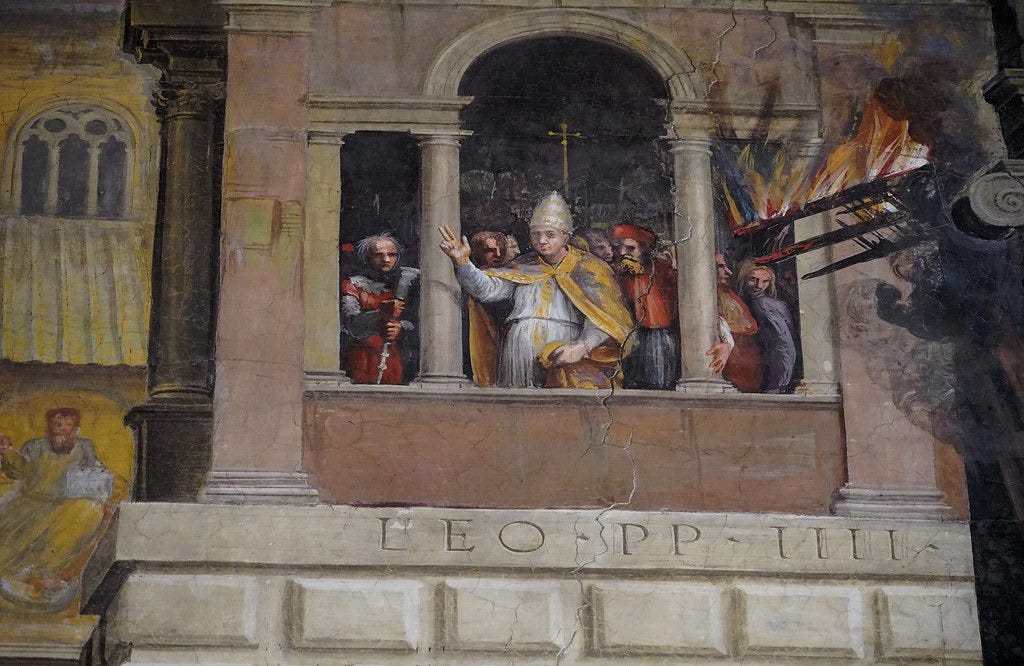Leo IV: The Wall Builder of the City of God
The Fourth of the Leos | Pope Leo IV (847–855 AD)
“He who watches over Israel shall neither slumber nor sleep.”
— Psalm 120:4, Douay-Rheims
By the mid-9th century, Rome no longer trembled before barbarian hordes alone. The terror now came by sea: fleets of Muslim raiders sweeping in from North Africa, burning churches, plundering relics, and carrying off the innocent into slavery.
Into this long night of anxiety stepped Pope Leo IV, the fourth Leo—less a roaring conqueror, more a vigilant sentinel. In his hands, the papacy became both a spiritual fortress and a literal one.
Where Leo I defended doctrine, and Leo III crowned an empire, Leo IV girded the Church in stone and sacrament, that the faith might outlast the flames.
The Man Behind the Walls
Leo was born in Rome, probably around 790 AD, the son of a man named Radoald. As a young cleric, he was known for his purity of life and wisdom in administration. He served as subdeacon and then priest under Pope Gregory IV.
After the death of Pope Sergius II in 847, Leo was elected with rare unanimity—so evident was his worthiness. At his consecration in St. Peter’s Basilica, the people must have wondered whether this mild and prayerful man could lead them through the storm.
History would soon answer that question.
Rome in Ashes
Barely a year before Leo’s election, Muslim raiders had carried out the Sack of Rome in 846—plundering the basilicas of St. Peter and St. Paul, which lay outside the Aurelian Walls. Gold and silver were torn from the tombs of martyrs. Pilgrims were slaughtered at the altars.
Leo saw this not only as a crisis of security, but a test of faith. He began a project of rebuilding so ambitious that it would leave his name inscribed in the very stones of Rome.
The Leonine Wall
Leo ordered the construction of a massive new fortification—a defensive wall around the Vatican Hill, enclosing St. Peter’s and the Borgo quarter. This wall, known ever since as the Leonine Wall, still stands today in parts, an enduring testament to his foresight.
It stretched nearly three kilometers, rising up to 40 feet high, with fortified towers and battlements. In the hour of peril, Leo IV became the mason of Christendom—a pope whose faith could be measured in mortar and brick.
He also established a naval alliance among maritime cities—Gaeta, Amalfi, and Naples—to repel further raids. In 849, when another Muslim fleet threatened Rome, a coalition fleet met it in the Battle of Ostia. The Christian ships, aided by a providential storm, utterly routed the invaders.
Legend tells that Pope Leo himself stood on the shore, arms outstretched in blessing, as the wind rose—another moment when the successor of Peter prayed Rome to safety.
A Shepherd of Reforms
Yet Leo IV’s legacy is not only military. He:
Restored and adorned St. Peter’s Basilica, adding a new golden mosaic of Christ enthroned.
Convened synods to discipline clergy and correct abuses.
Strengthened monastic life, seeing in the quiet prayer of monks the hidden bulwark of the Church.
Crowned Louis II as Emperor in 850 AD, sustaining the fragile bond between papacy and empire.
Leo ruled with firmness and gentleness. His contemporary biographers described him as “humble in heart, yet resolute in deed.”
A Death in Peace
After eight years of vigilance, Leo IV died on July 17, 855 AD, likely exhausted by the labor of defending both the city and the faith. He was buried in St. Peter’s Basilica, near the walls he had built.
The medieval chroniclers later told stories that in the Leonine Wall, a single brick was laid by the Pope’s own hand each day, and that every evening he walked the perimeter, praying aloud the psalms. Whether legend or fact, such tales bear witness to his spirit: a watchman who would not sleep until the City of God was safe.
“Except the Lord build the house, they labour in vain that build it: except the Lord keep the city, he watcheth in vain that keepeth it.”
— Psalm 126:1, Douay-Rheims
Leo built walls not because he trusted in stone, but because he trusted that God blessed human effort rightly ordered. Faith does not scorn prudence; it perfects it.
The Vigil of the Lion
Pope Leo IV reminds us that sometimes the Church must raise walls and fleets to protect what is holy. But those defenses alone are never enough.
The true strength of Rome was not brick, but prayer. Not the height of her towers, but the humility of her shepherds.
In an age when the faith is again assailed—by ideologies more subtle than raiders—Leo IV teaches us the power of watchfulness, of building what will outlast us, of tending the vineyard with hands calloused by labor and folded in prayer.
His was the lion’s silent vigil.


